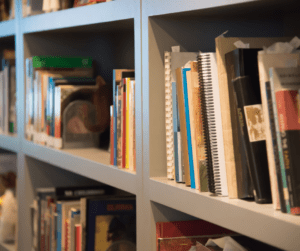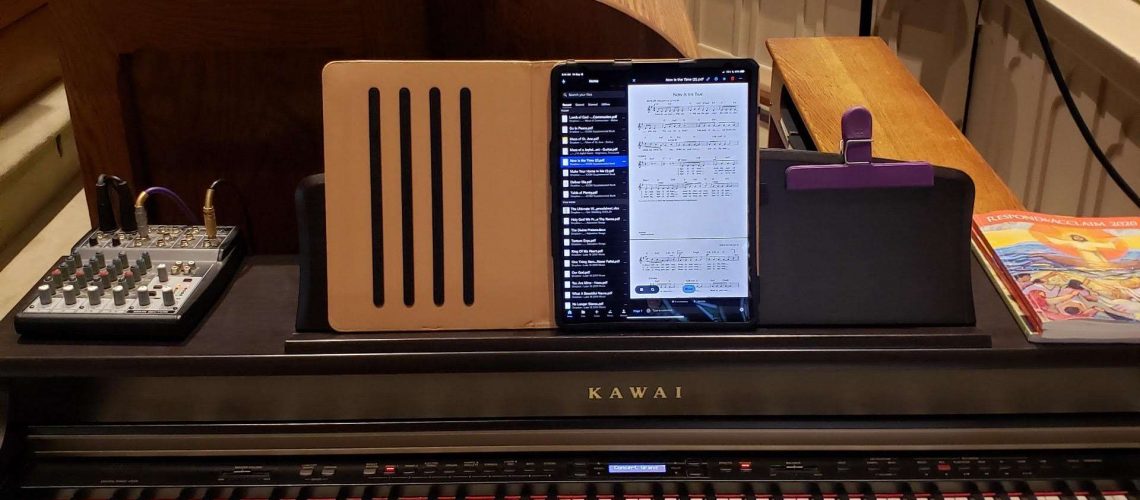Over the last several years and especially during the pandemic, the way we as musicians and liturgists plan, prepare, and play at Mass has taken huge leaps in the direction of technology. Personally, I have come to love the new advantages of using technology, mostly using tablets and transitioning to an all digital music collection.
Like most musicians playing at Mass I started with a binder. Although, more affectionately known to me as The Binder. The safe haven of all my music for future Masses and liturgical celebrations, usually packed with a few other gems of ‘just in case Fr. says something’ or ‘I do not want to lose this’. For me, one of those extra gems was the RCIA dismissal song.
The Beloved Binder
Over the years of use The Binder went through the regular wear and tear and my humble pile of music became a massive heap of music I had been given, accumulated, didn’t want to lose, and so that I knew I was never going to sort. Essentially, I had become a hoarder of sheet music! But haven’t we all?

My bookshelves had become overflowing with music I would either most likely never use or get a different copy if I needed it anyway. Between my music for Church, my personal music, the songs I always wanted to learn when I finally had enough time and the music I played with my cover band at our yearly parish picnic, I realized something different needed to happen. Something needed to change.
I needed an option that was free of clutter, easy to operate, and long lasting or in other words I needed something simple, effective, and durable.
Step #1 Find your new bread and butter.
I had recently purchased an iPad for college and starting using a website called Dropbox. Little did I know, both tools would later become the bread and butter of my musical world and more importantly replace my music library! The good news is that iPads, Microsoft Surfaces, and Samsung tablets are just a few of the many options available in finding and implementing the right tablet. I went with an iPad, starting with a mini and eventually upgrading to the 12.9-inch version.
Step #2 Make a list and check it twice
However, let us first look at how I was able to digitize, store, and access my new digital music collection. The ‘pretty’ answer is that it takes time, patience, and perseverance. The ‘boring’ answer is that I used a scanner, flash drive, and Dropbox. I began by making a list of all my music, marking down what I needed/wanted to be digital and what already was.
Step #3 Creating the Digital Music Collection
After I was done with that, I began scanning my music on my printer to save as pdfs on my flash drive. Then I made detailed folders in which to store all my music. Finally, I was able to put the music on Dropbox.
It is important to take the time to find which storage and viewing systems and apps work best for you. Personally, I have always used Dropbox, however there are a whole host of options, the most prominent being Google Drive. My suggestion is to use some trial and error and find what works best for you. I’ll speak more on this in the following installments.
Advantages of everything in one spot
With the use of the Dropbox app on my iPad I was able to access all my music at a moment’s notice while never having to print, sort, copy, collate or deal with paper. However, while I quickly saw the fruits of the change it was not a simple ‘do it in a day’ project. It took time, planning, execution, and dedication BUT it was so worth it.

I took my time though. The first few weeks and months that I began to use my iPad as my primary music source, I always kept a few extra paper copies of certain pieces at the ready. However, I came to find that I rarely, if ever, used them. All in all, the move from paper to tablet was rewarding. I was freed of my seemingly never ending pile of music and given the ability to focus more on my craft.
Many of the big publishers offer their catalogs in addition to their octavos and paper copies of music at additional cost. At Simply Liturgical Music, the entire library is digital and ready to be uploaded to your new trusty digital folder collection. SLM’s unique platform is six-fold: 100% Digital, 100% Green, allow Infinite Copies, 100% Fair, 100% Direct and 100% Just. I am so glad I transitioned to a digital music collection, and I encourage you to learn more about this platform and how it’s changing the liturgical music industry.
Next, I’ll go into greater detail and with examples on how to handle this process!

